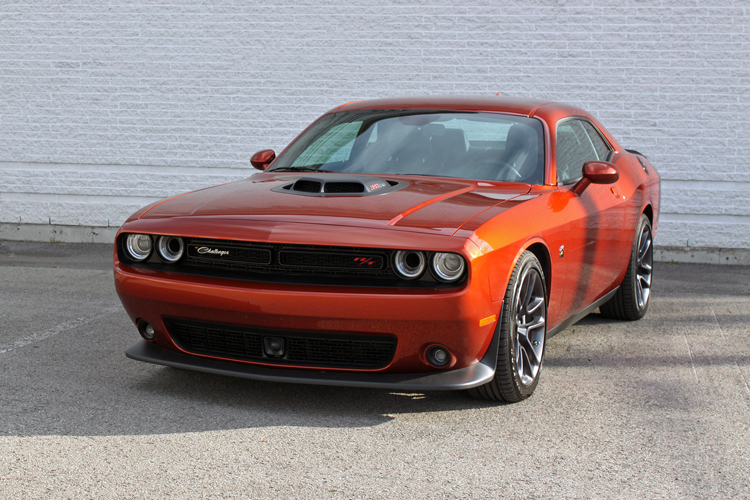
Scat Package 2 added a Mopar cat-back exhaust and an optimized engine calibration that required the use of premium octane fuel.

Scat Package 1 included a Mopar cold-air intake, a Mopar short-throw shifter, and Mopar performance brakes with slotted rotors and high performance brake pads.
SCAT PACK CHALLENGER MANUAL
Scat Package 3 for the Hemi went all out and included Mopar performance CNC ported cylinder heads, Mopar hi-flow headers, engine calibration, and the Scat Package 3 badge, giving an extra 58 horsepower for a total of 433 horsepower in a Challenger equipped with the manual transmission.įor Dodge Darts equipped with the 2.4 liter Tigershark engine the Scat Packages improved both horsepower and handling. Scat Package 2 added a Mopar performance camshaft, along with a new engine calibration and the Scat Package 2 badge for up to 30 extra horsepower over the standard car. Scat Package 1 added up to 18 horsepower and included a Mopar cold-air intake and cat-back exhaust to improve engine breathing, and a new engine controller, calibrated for the Hemi engine and new parts. On Challengers and Chargers with the 5.7 liter Hemi engine, each of the Scat Packs were designed to add horsepower. Three kits were available for each car, with each kit building on the previous one to add performance while maintaining the car’s original warranty. Patent and Trademark Office and it had to fight a lawsuit with Scat Enterprises, an aftermarket supplier of crankshafts, connecting rods, and rotating assemblies, which claimed that it was the rightful owner of the “Scat” trademark.Īfter the 2013 Las Vegas SEMA show, Dodge reintroduced the Scat Pack as optional multi-stage kits for the 2014 Challenger, Charger, and Dart, in order to mark the 45th anniversary of the original Scat Pack. The revival of the brand did not come easy, however, since Dodge’s trademark request was initially denied by the U.S. Still, for a brief shining moment the Scat Pack demonstrated what could be accomplished with just a little creativity and a lot of horsepower, and paved the way for its own revival many decades later.įortunately, Dodge brand head Tim Kuniskis championed the resurrection of the Scat Pack name shortly after taking over Dodge in April 2013. The year 1973, however, spelled doom for most American muscle cars as insurance concerns and emissions regulations slowly choked the life out of large V8s- a sad state of affairs that would last until the mid-80s. So successful was the entire initiative that Plymouth got into the act with its “Rapid Transit System” which would run from 1970 to 1972, and included the ‘Cuda, the GTX, the Superbird, the Duster 340, and the Roadrunner. By 1970, the family had grown to include the Charger Daytona and the Dodge Challenger and, in the final year, the 1971 Dodge Demon 340 was also included.

SCAT PACK CHALLENGER FULL
Collectively the group of Dodge performance cars was referred to as “the hive.” The marketing team went on the warpath, blanketing dealerships, magazines, and television with references to “Scat City” and the full line-up of Scat Pack cars. The Scat Pack logo was a variation on the drag-racing Super Bee found on the Dodge Super Bee. For the money, members received a monthly newsletter, a quarterly magazine, a wallet card declaring their loyalty, a bumper sticker and jacket patch, and a racing guide. It was a play on words- the Rat Pack had been Frank Sinatra’s gang of Hollywood pals that became legendary for their partying and the pictures they made together- and, as such, Dodge also created an actual Scat Pack Club that both owners and Mopar fans could join for the very affordable price of three dollars. The problem was put to the talented team at the Ross Roy Ad Agency, which came up with the ingenious idea of the “Scat Pack” designation. What was missing, however, was a way to unify each of these uniquely-named models under a single, world-beating banner- an issue that would only get worse with the introduction of the Dodge Super Bee mid-year.

In the early 1960s, Dodge had many exciting high performance cars, such as the 1963 Polara 426 Max Wedge, 1966 Coronet 426, 1967 Dart GTS 340, 1967 Charger R/T 383, etc. It became legendary in the enthusiast community and symbolized one of the most feared groups of street machines every to rumble from stoplight to stoplight. Mainly a marketing term, Scat Pack cars got twin bumblebee stripes and special decals. In order for a car to enter the Scat Pack it had to be capable of running the quarter mile in the 14s (14.99 sec. In 1969, the Charger Daytona joined the Pack. The Dodge Scat Pack was originally introduced in 1968 with the Charger R/T, Coronet R/T, Dart GTS, and Super Bee.


 0 kommentar(er)
0 kommentar(er)
